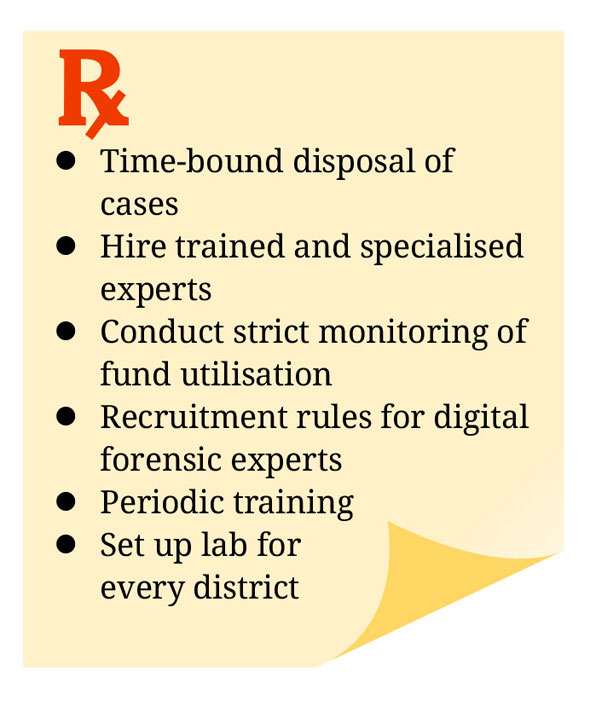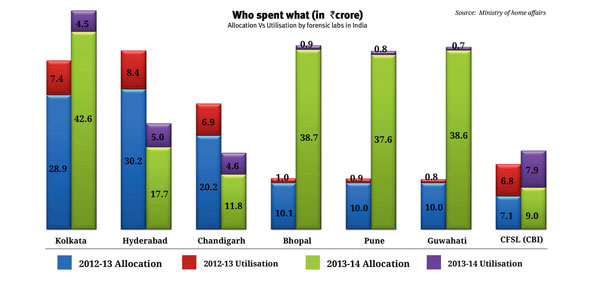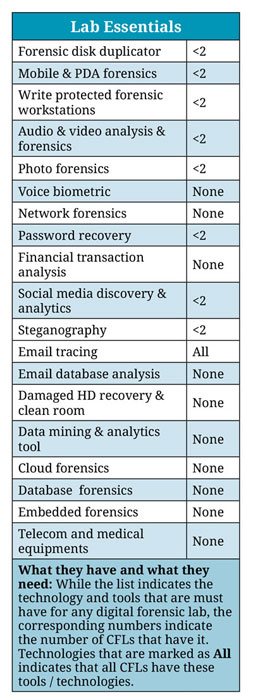Government forensic labs lack expertise, technology and accountability, forcing our elite investigation agencies to go to private units
It’s a curious case of privatisation by delay. Indian law enforcement agencies routinely use private laboratories for the analysis of digital evidence as government-owned forensic laboratories take up to 12 months in some cases. The list includes the who’s who of India’s elite investigators: national investigation agency (NIA), enforcement directorate (ED), central bureau of investigation (CBI) and even the Delhi police.
“If we send a request for analysis of evidence to central forensic science lab (CFSL) it takes three months to a year to get their inputs. We can’t wait that long. The delay gives time to convicts to maneuver and distort the evidence,” a senior official with a central investigation agency told Governance Now.

“It has happened in the high-profile 2G scam. During the first interrogation, officers accessed the email of one of the suspects. But they didn’t change the password. Later, some emails were deleted selectively by the suspect or people related to him. There is no way now to get back those emails as the email service provider is not based in India.” Not even one investigation agency Governance Now spoke to is satisfied with the working of government labs.
Whether it is a terrorist attack, a police encounter or a high-profile scam, the forensic analysis of electronic chips in cell phones, computers and CCTV cameras provide important leads to the investigation agencies. Legal regulations mandate forensic evidence to be certified by a government laboratory to be admissible in court as evidence. The investigators get around this by using the government laboratories to certify the results from private units.
What ails it?
Government laboratories face a multitude of problems. Firstly, they don’t have the required human resources. Out of the sanctioned strength of 584, the labs only have 407 officials. In past 10 years the directorate of forensic science services, the nodal body overseeing central labs, surrendered 117 posts. “Following the finance ministry’s order, the DFSS (directorate of forensic science services) surrendered the posts which had been vacant for more than three years,” said Dr AK Ganjoo, director-cum-chief forensic scientist of DFSS.
The DFSS comes under the police modernisation division of the ministry of home affairs (MHA). Ganjoo identifies the lack of career progression in CFSLs as an important reason for the manpower shortage. Secondly, only seven labs are being run by the central government. They include three old labs in Hyderabad, Kolkata and Chandigarh. One lab is under the CBI. The remaining three, in Bhopal, Pune and Guwahati, are a recent addition and still a work in progress. Only 20 experts are managing CFSL Chandigarh, which caters to cases from Chandigarh, Punjab, Haryana, Jammu and Kashmir and central law enforcement agencies. Ganjoo said each laboratory should have 100 experts.
Thirdly, fund utilisation by the CFSLs is poor. Despite being hobbled by lack of infrastructure, human resources and training fund use in the past three years has been less than 30 percent. Surprisingly, while fund allocation has increased its utilisation has gone down. In 2012-13, the allocation increased to '109.25 crore but the utilisation dipped to '25.34 crore. In 2013-14, the figures were '186.94 crore and '16.47 crore respectively. Fourthly, the government doesn’t have a separate recruitment rules (RR) for hiring of scientists under the digital forensics division in the labs. Except Gujarat, almost all state labs don’t even have a separate division for digital forensics. Two years back the forensic institute in Maharashtra requested the state government to make a separate RR for hiring post graduates in digital forensics. The file is still pending.

What reforms?
A government-appointed committee had flagged these challenges way back in 2003. The Justice Malimath committee on reform of criminal justice system had recommended revamping forensic capabilities. It noted that the conviction rate is consistently falling over the years and the forensic evidence, being clinching in nature, can reverse the trend to some extent.
The committee recommended setting up appropriate forensic science facilities in each district and regional labs at each police range HQs. It stressed on defining a mandatory time limit for submission of reports to the police and courts. The states must, it noted, revise the sanctioned strength of their labs. It also underlined the lack of training facilities.
“It must be noted that a trained scientist is far more productive than several untrained or semi-trained hands. We, therefore, recommend that NICFS (national institute of criminology and forensic science) should take upon its shoulders the responsibility of imparting professional training to the scientific personnel,” the committee said. It has been over 11 years and the recommendations have not been implemented.
Samir Datt, who runs a private digital forensic lab, Forensic Guru, told Governance Now: “The nature of the job is such that it requires continuous training. Software and hardware undergo changes in short durations. To keep track of changes you need skilled and dedicated manpower.” Forensic Guru has a long list of clientele, including NIA, ED and CBI. The forensic labs under state governments are no different.
A visit to the Delhi forensic science lab (FSL) showed the poor state of affairs at the computer forensics unit (CFU). “The CFU receives 30 to 40 cases in a month. We dispose 17 to 18 cases,” said an official at the CFU division.
The division has only two regular staff members. These two officials, however, are not digital forensic experts. One is a ballistic expert and heads the division at the Delhi FSL. The other official works with the documents division and has been given an additional charge of CFU. In fact, CFU is not even a separate division. It comes under the document division. To reduce pendency, the Delhi FSL hired five professionals on a contractual basis. But they have just two computers to serve as forensic work stations. There were two more workstations, but these machines are not functional anymore. The operational machines copy and retrieve data from the exhibits: the most basic functions in forensics that doesn’t require skills.
“If the chip, be it mobile or computer, is password protected, it is very difficult to retrieve data. You have to have password recovery kit for every handset,” said one CFU official. “We simply write to the investigating agency that we don’t have the kit.” For instance, a case file of betting in cricket world cup final of 2011 came to the Rohini laboratory the same year and is still pending. Sometimes police officials also add to the delay by approaching FSL after two to three months of the crime and seizure of exhibits. This happens in majority of the cases,” one official claimed. He said that the lab officials are not provided adequate training.
“There are software like FTK and Encase which we use in our workstation. But we don’t know much about it. There are online courses that cost $400 to $500. But we don’t have fund allocation for such courses,” the official said. The situation at virtually all labs is the same. “At the Hyderabad lab, the officials with the chemistry division have been given the additional responsibility of the digital forensics,” said a senior forensic official with one of the government run labs. The Chandigarh lab is no different.
Gujarat, however, is one exception. The Gandhinagar forensic lab run by the state government is one of the best in the country. Normally the digital forensic division, carved out in 2003, gives its report back to the law enforcement agency in a month. In cases of murder and rape, the lab responds in two-three days. The lab has a separate division for digital forensics with nine dedicated officials.
“We have procured cutting-edge technology for the lab. The digital forensics division has eight high end forensic workstations,” said HP Sanghvi, deputy director, Gandhinagar FSL. The fund utilisation is 99 percent, said Sanghvi. The state government set up a forensic science university in 2009. It offers courses in 32 different forensic divisions. The students enrolled in post-graduate programme in computer forensics are interned at the Gandhinagar lab. The officials at the lab too undergo regular training at the varsity.
The central government seems to have taken note of the state of forensic labs and their inability to keep up with technological changes. In February 2013 the MHA approved '285 crore for establishment of new CFSLs and expansion and modernisation of existing CFSLs. Under this plan, the DFSS will complete setting up of hi-tech labs in Bhopal, Pune and Guwahati. The directorate will also add six new divisions, including forensics electronics, narcotics, DNA and forensic intelligence to the existing CFSLs. The DFSS will spend '30 crore each on sourcing machines and human resources.
In 2013, the government extended the scheme for recruitment of scientists—flexible complementing scheme (FCS) which provides for timely promotion—to cover the DFSS. Now, scientists working at the central labs can be promoted to director’s level in ten years. The government notified the same on December 31, 2013. After the sixth pay commission, the salary has also become lucrative. This might solve the issue of human resource to some extent, said Ganjoo. The effectiveness of these measures, however, remains to be seen.


